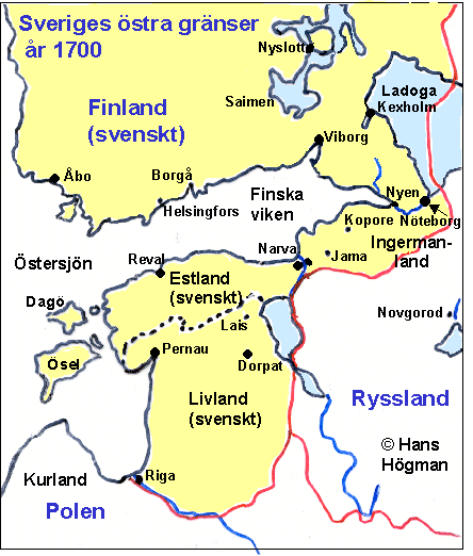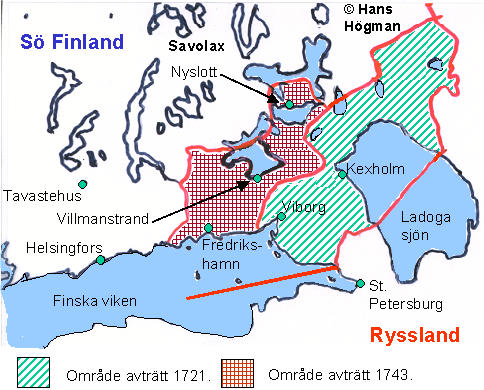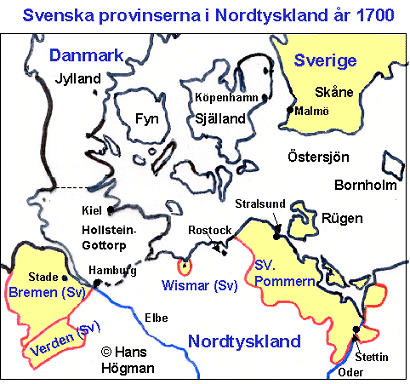

Copyright © Hans Högman 2017-09-13
The Swedish / Russian border -
The Baltic Provinces, 1700
Maps of the Swedish
foreign provinces
In 1561 the Estonian knighthood, including the city of
Reval (today’s Tallin), turns themselves into Swedish
hands (western part of Estonia).
In 1595 Sweden also receives the eastern part of
Estonia. Further, Sweden gains the western part of
Ingermanland and the major part of Kexholmslän at
the Karelian Isthmus.
The city of Riga was captured in 1621 and the
northern part of Livland (north of river Düna) was
occupied by the Swedes. In the armistice in Altmark
in 1629 between Sweden and Poland, Poland had to
accept the Swedish occupation of Livland.
In 1617 the rest of Kexholmslän becomes Swedish,
that is the whole part of the Karelian Isthmus.
Further the western part of Ingermanland (Nöteborg,
Jama, Kopore och Ivangorod).
Sweden now has a connected territorial area from
Finland through the Baltic provinces down to Riga.
See map above.
The island Ösel, earlier a Danish island becomes
Swedish in 1645.
All of the Swedish Baltic provinces are lost after the
Great Nordic War in the peace treaty with Russia in
Nystad 1721. We then lost Ingermanland, Livland,
Estonia and part of Karelia plus the city of Viborg.
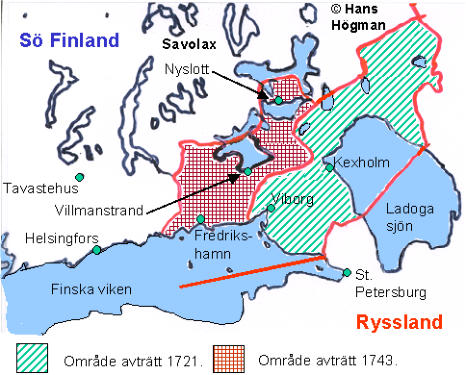
Dictionary:
•
Swedish
English
•
Sverige
Sweden
•
Ryssland
Russia
•
Polen
Poland
•
Svenskt
Swedish dominion
•
Estland
Estonia
•
Ingermanland
Ingria
•
Estland
Estonia
•
Livland
Livonia
•
Finska viken
Gulf of Finland
•
Östersjön
Baltic Sea
•
Ladoga
Lake Ladoga
The rightmost red border line shows the original
border line between Finland and the Swedish province
of Ingermanland and in the east towards Russia. The
green area marks the area of Finland lost to Russia in
1721. The red area marks land lost to Russia in 1743.
The Swedish provinces in Northern
Germany 1700
Dictionary:
•
Swedish
English
•
Sverige
Sweden
•
Danmark
Denmark
•
Nordtyskland
Northern Germany
•
Köpenhamn
Copenhagen
•
Jylland
Jutland
•
Själland
Zealand
•
Östersjön
Baltic Sea
•
Sv
Swe = Sweden
•
Pommern
Pomerania
In the peace treaty of Westfalen in 1648 after the
30-Year War Sweden gained Vorpommern, a small
part of Hinterpommern and the islands Rügen,
Usedom and Wollin. Further Wismar, Bremen and
Verden plus the provinces Wildeshausen and
Thedinghausen.
The area called Swedish Pommern was in large
Vorpommern.
Sweden had to give up the provinces Thedinghausen
and Dörverden with an area between river Weser
and the tributary Aller in 1679. Further, Brandenburg
received a part of Swedish Pommern or more exactly
a small area east part of river Oder the very same
year.
In the Great Nordic War, which finally ended in 1721,
Sweden lost Bremen, Verden and the southern part
of Vorpommern.
The rest of Pommern is in Swedish hands until 1814.
Sweden then captured Norway from Denmark. As a
compensation Denmark received Swedish Pommern.
However, a year later, a conference in Vienna
decided that Swedish Pommern should belong to
Prussia instead of Denmark since Denmark hadn't
fulfilled the terms of the peace treaty of 1814 in Kiel.
Norway belong to Sweden until October 26, 1905
when they became an independent nation through a
parliamentary decision.
Wismar was pawned to Mecklenburg for 100 years in
1803 as collateral security for a bank loan.
Swedish Pomerania after 1720
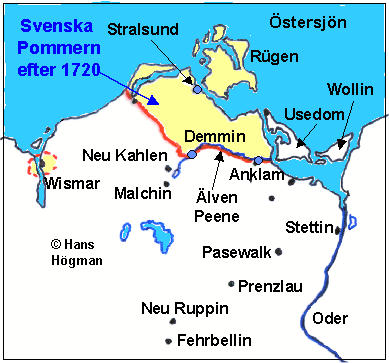
Dictionary:
•
Swedish
English
•
Sverige
Sweden
•
Nordtyskland
Northern Germany
•
Östersjön
Baltic Sea
•
Svenska
Swedish
•
Pommern
Pomerania
The Swedish borders before 1658
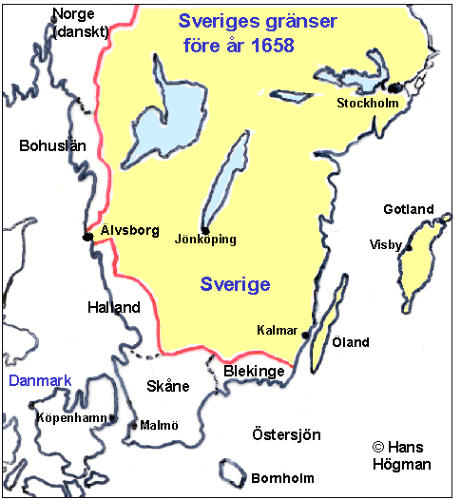
Earlier, the provinces Skåne, Blekinge, Halland and
Bohuslän belonged to Denmark. Sweden only had a
small part of land around Älvsborg as the only
gateway on the west coast.
The Kalmar War of 1611 - 1612 had shown how
difficult it was for Sweden to defend Älvsborg, as
long as the Danes possessed land south and north of
Älvsborg (were today's Gothenburg is located).
Twice, in 1570 and 1613, Sweden had to pay a
ransom to regain Älvsborg from the Danes.
In the peace treaty of Brömsebro in 1645, Sweden
received Halland on the west coast for 30 years plus
permanently the provinces Jämtland, Härjedalen, the
island Gotland and the island Ösel (in the Baltic
region).
In the peace treaty of Roskilde in 1658, Sweden
received the Danish provinces; Skåne, Blekinge,
Halland, Bohuslän, the island Bornholm and
Trondheim county in today’s Norway. Halland
became Swedish for a period of 30 years in the
peace treaty of Brömsebro in 1645. Now it
permanently became a Swedish province.
However Trondheims län and Bornholm was
returned to Denmark in 1660.
Dictionary:
•
Swedish
English
•
Sverige
Sweden
•
Danmark
Denmark
•
Norge
Norway
•
Köpenhamn
Copenhagen
•
Danskt
Danish
•
Själland
Zealand
•
Östersjön
The Baltic Sea







